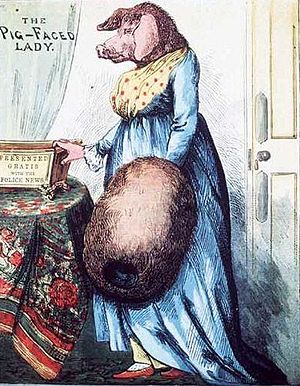
Legends featuring pig-faced women originated roughly simultaneously in The Netherlands, England and France in the late 1630s. The stories tell of a wealthy woman whose body is of normal human appearance, but whose face is that of a pig.
In the earliest forms of the story, the woman's pig-like appearance is the result of witchcraft. Following her wedding day, the pig-faced woman's new husband is granted the choice of having her appear beautiful to him but pig-like to others, or pig-like to him and beautiful to others. When her husband tells her that the choice is hers, the enchantment is broken and her pig-like appearance vanishes. These stories became particularly popular in England, and later in Ireland.
The magical elements gradually vanished from the story, and the existence of pig-faced women began to be treated as fact. The story became particularly widespread in Dublin in the early 19th century, where it became widely believed that reclusive 18th-century philanthropist Griselda Steevens had kept herself hidden from view because she had the face of a pig. In late 1814 and early 1815, rumour swept London that a pig-faced woman was living in Marylebone. Her existence was widely reported as fact, and numerous alleged portraits of her were published. With belief in pig-faced women commonplace, showmen exhibited living "pig-faced women" at fairs. These may have not been genuine women, but shaven bears dressed in women's clothing. [citation needed]
Belief in pig-faced women declined, and the last significant work to treat their existence as genuine was published in 1924. Today, the legend is almost forgotten.